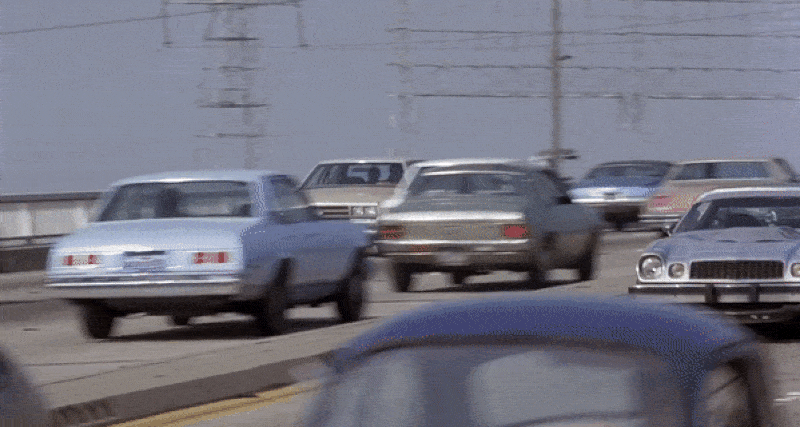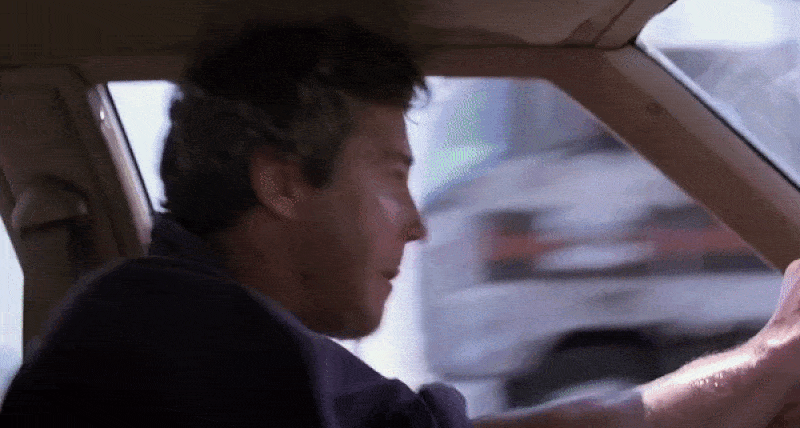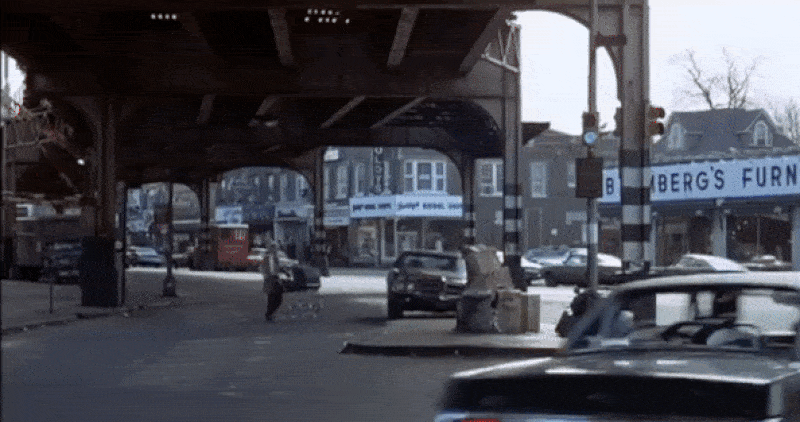Welcome to How’d They Do That? — a bi-monthly column that unpacks moments of movie magic and celebrates the technical wizards who pulled them off. This entry looks into the making of the car chase in To Live and Die in L.A.
William Friedkin‘s take no prisoners attitude is the stuff of legend. This is the man who shoots blank guns on set and films without permits while speeding through New York City at ninety miles per hour. The New Hollywood shenanigans bracket is competitive. But Friedkin is outrageous, passionate, and willing to go to great lengths to get what he wants.
It’s not a huge stretch to compare the director to Richard Chance, the hot-blooded cop played by William Petersen in Friedkin’s cat and mouse neo-noir To Live and Die in L.A. In the film, a fearless federal agent obsessively purses the counterfeiter (Willem Dafoe) who killed his partner, endangering himself and others in the process.
In many ways, To Live and Die in L.A. epitomizes Friedkin’s interest in the thin line between the cop and the criminal. Chance’s drive to seek and destroy leads him to commit reckless acts. Acts that rival those of the very man he’s hunting. You know, like speeding the wrong way down a Los Angeles freeway during rush hour.

In a characteristically dick-out move, Chance and his new, terrified partner Vukovich (John Pankow) hold up a known criminal who is carrying the cash they need to incriminate their real target, the counterfeiter. The robbery goes south, bullets start flying, and someone shoots the courier.
Soon enough, a simple getaway escalates into a multi-vehicle death race. The pair fails to shake their pursuers through alleyways and flood control channels. And so Chance — a cop fleeing like a criminal — is seemingly trapped. A “wrong way” sign beckons.
The tires squeal, and Chance’s Chevy Impala shoots head-on into traffic. Vukovich falls to pieces in the backseat as Chance weaves wildly between hundreds of oncoming cars, collisions erupting in his wake.
It’s a chase sequence that not only looks but feels real. You can see it on the screen: people did this. No wonky physics, no CGI. How the hell do you orchestrate something like that?
How’d they do that?
Long story short:
A lot of money and a lot of drivers. Oh, right and by making William Peterson drive the right way down the freeway. Wait…what?
Long story long:
According to stunt coordinator Buddy Joe Hooker, the chase scene was never scripted, let alone planned. But Freidkin and Hooker would frequently talk shop, and the idea for a chase scene began to take shape.
According to Hurricane Billy: The Stormy Life and Films of William Friedkin, Friedkin first conceived of a car chase against the flow of traffic while driving home from a wedding in 1963. As he tells it, Friedkin fell asleep at the wheel and woke up in the wrong lane headed straight into oncoming traffic. He swerved back to his side of the road and spent the next two decades wondering how he could use the experience in a movie.
Working with a stripped-down crew and Hooker’s diagrams, the eight-minute chase took six weeks to film and was the last sequence shot. In the making-of documentary Counterfeit World, Pankow jokes that by shooting the chase at the end of production, if anything were to happen to the lead actors the film would more or less be in the can.
“It was forty stunt guys, Friedkin, and Pankow and me,” remembers Peterson. “We were going all over LA, blocking off streets and just spinning out.”
The film’s director of photography (and noted Friedkin enabler) Robby Müller declined to shoot the chase over safety concerns, so the second unit cameraman, Robert D. Yeoman, came on instead. (Fun fact: Yeoman went on to become Wes Anderson’s DP of choice. So keep this man’s enormous balls in mind next time you scoff at a twee center frame.)
Peterson himself did most of the chase leading up to the freeway stunt. “I was able to do a lot of the driving stuff, and I wanted to do all of it,” remembers the actor. “It got to the point where it was much more fun to be doing the stunts than it was to be doing any of the acting stuff.”
Quote Pankow: “I didn’t really have to act. I was terrified a lot of the time.” Inserts and close-ups of Peterson behind the wheel of the Impala were accomplished with a specially designed hydraulic swivel car that was pulled behind a camera truck.
In other shots, where we see Chance driving in the camera car, the vehicles in the opposing lanes were stationary. This was apparently Friedkin’s idea. And according to Hooker, it created a strobe-effect: “you couldn’t tell if the cars were moving or not.”

As Peterson describes in a behind-the-scenes featurette, the film rented a portion of a freeway for the weekend and sourced nine-hundred (!) cars to give the impression of rush hour.
The car Chance drives is specifically a 1985 Chevy Impala F41. The LAPD rented it out, along with several other cars used in the film. Three weekends were spent on sections of the Terminal Island Freeway near Wilmington, California. These were closed for several hours at a time to allow the crew to stage and shoot the nightmarish chase.
Now, brace yourself for a twist. In the narrative of the film, Chance and Vukovich are driving against traffic. But, in reality, the opposite was true. Petersen and Pankow drove in the correct direction. Meanwhile, “traffic” actually flowed backward on the wrong side of the road. This is possible to spot in several brief cuts.
According to an interview with Hooker on Shout Factory’s Blu-ray release, one of the reasons Friedkin wanted Petersen and Pankow to drive in that particular direction was “because there were these beautiful oil refineries with all the lights, and it was a dusk shot. [Friedkin] wanted to see that in the background with the cars going and the only way he could do that was to reverse the flow of the traffic.”
There’s a moment near the end of the chase where the eighteen-wheeler jackknifes and squashes the cars in its path. This was Hooker’s idea. Like all good ideas, he suggested it before he knew how to pull it off.
To achieve the effect, the stunt team attached the back of the semi to a four-wheel-drive truck. When the tractor and trailer brakes locked up, the truck swung the back of the semi around with the cable.
As for the train jump, where our heroes outpace and cross in front of an oncoming train, as far as I can tell, they just staged and straight up did that.
What’s the precedent?
Friedkin has a weakness for car chases. If you were to compile a list of the most impressive car chases in cinema, Friedkin’s name would certainly appear in the top ten… multiple times. In his memoir, he refers to them as “the purest form of cinema, something that can’t be done in any other medium, not in literature nor on a stage nor on a painter’s canvas.”

In 1971, Friedkin revolutionized the car chase with The French Connection. Shot on open New York City streets, with Gene Hackman doing a good chunk of the stunt driving himself, the sequence contains an exhilarating lack of control (with the unplanned accidents to show for it).
In the sequence, detective Jimmy “Popeye” Doyle (Hackman) commandeers a civilian’s car and chases after the elevated train on which a hitman is making his escape.
Basically, the sequence was about as dangerous to shoot as it looks. Much of the chase was shot on busy streets with no traffic control and no permits (Friedkin, on permits: “what are they?“). It’s a kinetic, frantic five minutes with Popeye in a Pontiac LeMans careening through unsuspecting traffic at a frightening speed.
Friedkin has since acknowledged that he endangered lives for the sake of capturing a thrilling sequence. Furthermore, he’s stated he would never shoot anything the way he shot The French Connection chase again. But, in his memoir, Friedkin admits to feeling a need to surpass The French Connection chase.
And so, when it came time to brainstorm a chase for The Live and Die in L.A. there it was: no one had done an against traffic chase at high speed. Like Dick Chance says: we’re going this way. While Friedkin may not have necessarily eclipsed his first iconic chase, in my books, he certainly matched it. And with permits no less!


0 comments:
Post a Comment